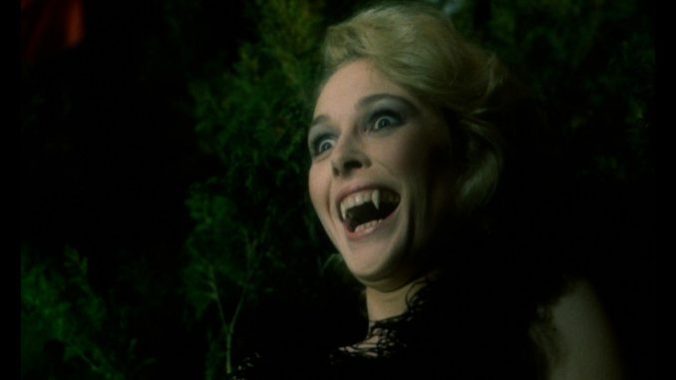Kier-La Janisse’s Work Meets a New Feminist Essential in House of Psychotic Women: Rarities Collection

Who gains the most from Severin’s impressive House of Psychotic Women: Rarities Collection: The psychotic women in each of the set’s four films, or Kier-La Janisse, the scholarly woman who coined their appellation? It’s a head-scratcher. Fortunately, there’s always an easy way out: Pick option c), the audience, the ultimate beneficiaries of both Janisse’s efforts at mapping cinema’s long history of presenting beleaguered female characters as they unravel before our eyes, and Severin’s efforts at restoring deep cuts in Janisse’s psychotic women canon.
Typically, mention of Janisse’s seminal genre text, House of Psychotic Women, first published in 2012, conjures up a handful of popularized titles: Thriller: A Cruel Picture, Repulsion, What Ever Happened to Baby Jane?, Twin Peaks: Fire Walk With Me and especially Andrzej Zulawski’s Possession, the standard-bearer of psychotic women films. Though words like “epic” or “iconic” have been drained of meaning by pop culture, “iconic” is the most correct way to describe Possession. A picture arguably known best for the image of Isabelle Adjani thrashing in a quagmire of her own inscrutable bodily fluids, a viscous breakdown suffered alone in a West Berlin subway station, Possession occupies considerable real estate in the psychotic women movie canon. There’s nothing wrong with the influence it wields, mind you. It’s held in high esteem for good reason, Adjani’s performance in particular.
But a canon mustn’t be defined by a single movie, or even a single subset of movies, and here lies the value of House of Psychotic Women: Rarities Collection: Spotlighting a quartet of films typically overlooked when invoking the phrase “psychotic women.” In Grzegorz Warchol’s I Like Bats, Izabela (Katarzyna Walter), a young, single vampire content with her unlife, falls hard for hunky psychiatrist Rudolf Jung (Marek Barbasiewicz), and rapidly loses her grip on her selfhood; in Jane Arden’s The Other Side of the Underneath, experimental cinema combines with radical theater in a surrealist, challenging and mentally taxing series of therapy sessions with a handful of schizophrenic patients; in Luigi Bazzoni’s Footprints, Alice (Florinda Bolkan) wakes up one morning to find that she’s either slept for several days straight or forgotten what happened to her throughout those days; and in Giuseppe Patroni Griffi’s Identikit, Lise (Elizabeth Taylor) takes a Roman holiday in search of something she won’t articulate and which the audience doesn’t find out about until it’s too late.
House of Psychotic Women: Rarities Collection gives each of these titles their first U.S. Blu-ray release, but Identikit is clearly intended as the set’s marquee film: Taylor’s image serves as the box’s cover art, as well as the menu background on all four discs. This feels like a nod to the immediate recognizability conferred on Taylor by her screen legend status, which in turn confers recognizability on the set. Taylor commands attention, a quality central to Lise and Identikit’s fractured narrative: She strides through space after space, room after room, performatively purposeful but obviously unnerved, like she’s cold but either too proud or too bashful to put on a coat. It’s impossible not to look at her, for viewers, for passersby in the streets, for INTERPOL agents observing her through security footage in between interrogating people who have randomly encountered Lise while going about their days. Partly it’s Lise’s outfit—she resembles a runaway circus tent wearing a knotty, bedraggled wig—but mostly it’s her deportment. She carries herself like a star when she’s more of a bolide.
Why would Lise want to attract attention to herself while architecting her own murder? That’s Identikit’s real mystery. But attention plays a key role in tying House of Psychotic Women: Rarities Collection’s films together through a common theme, apart from the “psychotic” detail. Izabela vigorously eschews male attention in I Like Bats; Alice is wary of attention in Footprints; the therapist in The Other Side of the Underneath, played by Arden herself, attends her patients’ breakdowns and mental unrest, not necessarily the products of behavioral illnesses but undoubtedly influenced by behavioral strain. Wanting to be seen and not wanting to be seen, and the complications of how society sees women period, are core attributes to these movies. In a bitter stroke of irony, the audience plays into or tramples over the wishes and desires of each protagonist by the mere act of watching, which could be read as part of the point of the exercise.
-

-

-

-

-

-

-

-

-

-

-

-

-

-

-

-

-

-

-

-

-

-

-

-

-

-

-

-

-

-

-

-

-

-

-

-

-

-

-

-








































